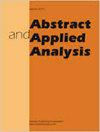Projections in Moduli Spaces of the Kleinian Groups
Q3 Mathematics
引用次数: 0
Abstract
Kleinian群模空间中的投影
一个双生成子Kleinian群f,g可以自然地与离散群f相关联,具有二阶的生成器ξ,并且其中f,ffe f ffe−1=f,g f g−1⊂f、g,fffe:f,g f g−1=2。这对于研究Kleinian群的几何是有用的,因为f,g只有当f,Γ是并且群f,ξ是一个复杂的维度。这给出了在一个简单空间中确定f,g离散性的一个必要条件。这里的降维是通过两个生成Kleinian群的主要特征的投影来实现的。在应用中,重要的是要知道在这种投影下Kleinian群的模空间的图像是封闭的,并且,在其他结果中,我们从Jørgensen关于代数收敛的结果中展示了这是如何得到的。
本文章由计算机程序翻译,如有差异,请以英文原文为准。
求助全文
约1分钟内获得全文
求助全文
来源期刊
CiteScore
2.30
自引率
0.00%
发文量
36
审稿时长
3.5 months
期刊介绍:
Abstract and Applied Analysis is a mathematical journal devoted exclusively to the publication of high-quality research papers in the fields of abstract and applied analysis. Emphasis is placed on important developments in classical analysis, linear and nonlinear functional analysis, ordinary and partial differential equations, optimization theory, and control theory. Abstract and Applied Analysis supports the publication of original material involving the complete solution of significant problems in the above disciplines. Abstract and Applied Analysis also encourages the publication of timely and thorough survey articles on current trends in the theory and applications of analysis.

 求助内容:
求助内容: 应助结果提醒方式:
应助结果提醒方式:


